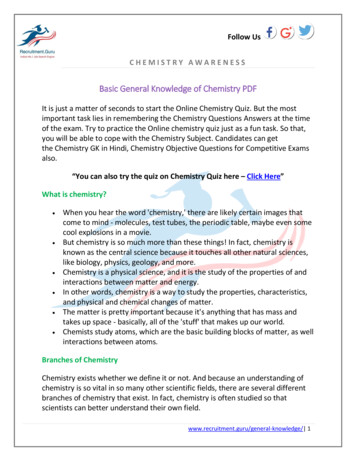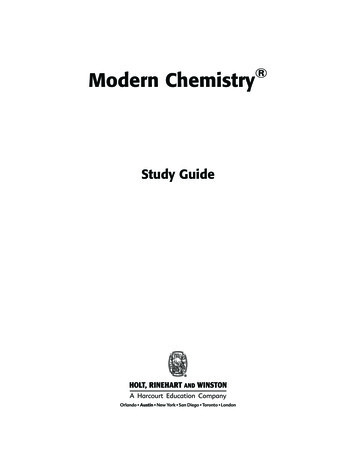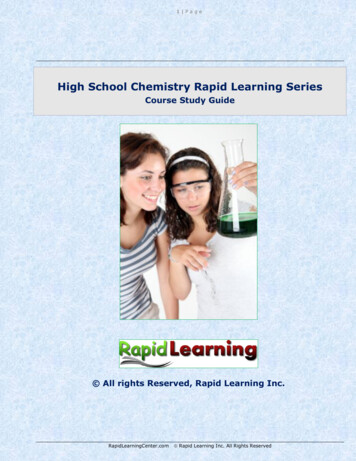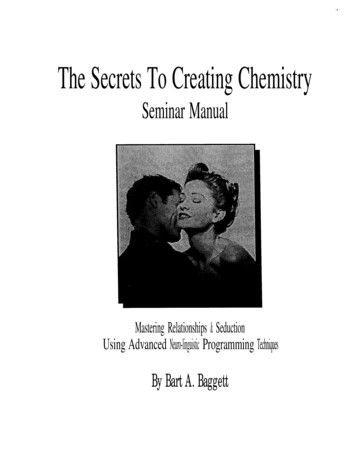
Transcription
The Chemistry of FragrancesPerfumes and More28 March 2019
The Chemistry of FragrancesPerfumes and More28 March 20191. Brief History
The Chemistry of FragrancesPerfumes and More28 March 20191. Brief History2. Nobel Prize (2004)
The Chemistry of FragrancesPerfumes and More28 March 20191. Brief History2. Nobel Prize (2004)3. Catalytic Preparation of Fragrances
The Chemistry of FragrancesPerfumes and More28 March 20191.2.3.4.Brief HistoryNobel Prize (2004)Catalytic Preparation of FragrancesIndustrial Organometallic Processes
The Chemistry of FragrancesPerfumes and More28 March 20191.2.3.4.5.Brief HistoryNobel Prize (2004)Catalytic Preparation of FragrancesIndustrial Organometallic ProcessesToxicology Outline
The Chemistry of FragrancesPerfumes and More28 March 20191.2.3.4.5.6.Brief HistoryNobel Prize (2004)Catalytic Preparation of FragrancesIndustrial Organometallic ProcessesToxicology OutlineReview of Flavor & Fragrance (2018)
Brief History of Fragrances 1850: only the wealthiest could affordfragrances and perfumes 1900: Perfumes were made of entirely naturalmaterials 2019: over 3000 fragrance ingredients areavailable to consumers ( 90% chemicallysynthesized) Expected in everything from household cleaners to shampoo to processedfood and more!Fortineau, A.-D., Chemistry Perfumes Your Daily Life. J. Chem. Educ. 2004, 81 (1), 45.
Brief History of Fragrances Use of fragranced materials dates backthousands of years “Perfume” comes from Latin per fume meaning“through smoke” as in the burning of incense Egyptians pressed, boiled, dried, powdered,macerated in fat, and even distilled The early Crusades spread perfumes to MiddleAge Europe Alchemy turned into chemistry in the 19th century, and fragrance was at theforefront 1882: Paul Parquet created Fougere Royale from synthetic coumarin,oakmoss, geranium, and bergamontFortineau, A.-D., Chemistry Perfumes Your Daily Life. J. Chem. Educ. 2004, 81 (1), 45.
Brief History of Fragrances Traditional discovery and development of new synthetic chemicals werebased on the analysis of natural sources: Plants (lavender, jasmine) Fruits (lemon, orange) Animal (musk, ambergris) Three main methods for acquiringFortineau, A.-D., Chemistry Perfumes Your Daily Life. J. Chem. Educ. 2004, 81 (1), 45.
Brief History of Fragrances Traditional discovery and development of new synthetic chemicals werebased on the analysis of natural sources: Plants (lavender, jasmine) Fruits (lemon, orange) Animal (musk, ambergris) Three main methods for acquiringExpressionFortineau, A.-D., Chemistry Perfumes Your Daily Life. J. Chem. Educ. 2004, 81 (1), 45.
Brief History of Fragrances Traditional discovery and development of new synthetic chemicals werebased on the analysis of natural sources: Plants (lavender, jasmine) Fruits (lemon, orange) Animal (musk, ambergris) Three main methods for acquiringSteam DistillationFortineau, A.-D., Chemistry Perfumes Your Daily Life. J. Chem. Educ. 2004, 81 (1), 45.
Brief History of Fragrances Traditional discovery and development of new synthetic chemicals werebased on the analysis of natural sources: Plants (lavender, jasmine) Fruits (lemon, orange) Animal (musk, ambergris) Three main methods for acquiringSolvent ExtractionFortineau, A.-D., Chemistry Perfumes Your Daily Life. J. Chem. Educ. 2004, 81 (1), 45.
Brief History of Fragrances Chanel No5 was the first commercial perfume to use synthetic materials Synthetic materials are: Cheaper Less prone to degradationFortineau, A.-D., Chemistry Perfumes Your Daily Life. J. Chem. Educ. 2004, 81 (1), 45.
Brief History of Fragrances Much like medicinal chemistry,derivatives are explored afternatural detectionFortineau, A.-D., Chemistry Perfumes Your Daily Life. J. Chem. Educ. 2004, 81 (1), 45.
Development of Types of OdorsMuskGautschi, M.; Bajgrowicz, Ja. A.; Kraft, P. Flavours and Fragrances 2001, 55, 379-387
Development of Types of OdorsWoodyGautschi, M.; Bajgrowicz, Ja. A.; Kraft, P. Flavours and Fragrances 2001, 55, 379-387
Development of Types of Odors‘Prodrug’ equivalence in perfumesGautschi, M.; Bajgrowicz, Ja. A.; Kraft, P. Flavours and Fragrances 2001, 55, 379-387
Development of Types of OdorsGautschi, M.; Bajgrowicz, Ja. A.; Kraft, P. Flavours and Fragrances 2001, 55, 379-387
Development of Types of OdorsGautschi, M.; Bajgrowicz, Ja. A.; Kraft, P. Flavours and Fragrances 2001, 55, 379-387
2004 Nobel Prize in Medicine & PhysiologyLinda B. BuckHoward Hughes Medical InstituteFred Hutchinson Cancer ResearchCenter.Richard AxelHoward Hughes Medical InstituteColumbia University College ofPhysicians and Surgeons
2004 Nobel Prize in Medicine & PhysiologyTwo main questions: How do mammals detect so many different environmental chemicals? How does the brain translate those chemicals into diverse odorperception and behaviors?Buck, L. B., Unraveling the Sense of Smell (Nobel Lecture). Angew. Chem. Int. Ed. 2005, 44 (38), 6128-6140.
2004 Nobel Prize in Medicine & PhysiologyTwo main questions: How do mammals detect so many different environmental chemicals? How does the brain translate those chemicals into diverse odorperception and behaviors?Humans can sense 10,000 to 100,000 chemicals (small, volatile)Buck, L. B., Unraveling the Sense of Smell (Nobel Lecture). Angew. Chem. Int. Ed. 2005, 44 (38), 6128-6140.
2004 Nobel Prize in Medicine & PhysiologyTwo main questions: How do mammals detect so many different environmental chemicals? How does the brain translate those chemicals into diverse odorperception and behaviors?Humans can sense 10,000 to 100,000 chemicals (small, volatile)G-protein coupled receptors (GPCR) were discovered to be responsible forodor detectionBuck, L. B., Unraveling the Sense of Smell (Nobel Lecture). Angew. Chem. Int. Ed. 2005, 44 (38), 6128-6140.
2004 Nobel Prize in Medicine & PhysiologyTwo main questions: How do mammals detect so many different environmental chemicals? How does the brain translate those chemicals into diverse odorperception and behaviors?Humans can sense 10,000 to 100,000 chemicals (small, volatile)G-protein coupled receptors (GPCR) were discovered to be responsible forodor detectionOdor receptors seem to be randomly distributedBuck, L. B., Unraveling the Sense of Smell (Nobel Lecture). Angew. Chem. Int. Ed. 2005, 44 (38), 6128-6140.
2004 Nobel Prize in Medicine & PhysiologyTwo main questions: How do mammals detect so many different environmental chemicals? How does the brain translate those chemicals into diverse odorperception and behaviors?Humans can sense 10,000 to 100,000 chemicals (small, volatile)G-protein coupled receptors (GPCR) were discovered to be responsible forodor detectionOdor receptors seem to be randomly distributedDifferent odorants can all trigger one type ofreceptor neuronBuck, L. B., Unraveling the Sense of Smell (Nobel Lecture). Angew. Chem. Int. Ed. 2005, 44 (38), 6128-6140.
2004 Nobel Prize in Medicine & PhysiologyAxel, R., Scents and Sensibility: A Molecular Logic of Olfactory Perception (Nobel Lecture). Angew. Chem. Int. Ed. 2005, 44 (38), 6110-6127.
2004 Nobel Prize in Medicine & PhysiologyWhy study smell?Axel, R., Scents and Sensibility: A Molecular Logic of Olfactory Perception (Nobel Lecture). Angew. Chem. Int. Ed. 2005, 44 (38), 6110-6127.
2004 Nobel Prize in Medicine & PhysiologyWhy study smell?It’s a primal senseAxel, R., Scents and Sensibility: A Molecular Logic of Olfactory Perception (Nobel Lecture). Angew. Chem. Int. Ed. 2005, 44 (38), 6110-6127.
2004 Nobel Prize in Medicine & PhysiologyWhy study smell?It’s a primal senseCan we study smell?Axel, R., Scents and Sensibility: A Molecular Logic of Olfactory Perception (Nobel Lecture). Angew. Chem. Int. Ed. 2005, 44 (38), 6110-6127.
2004 Nobel Prize in Medicine & PhysiologyWhy study smell?It’s a primal senseCan we study smell?It’s difficult tounderstand, but ithas tangible pieces(molecules &receptors)Axel, R., Scents and Sensibility: A Molecular Logic of Olfactory Perception (Nobel Lecture). Angew. Chem. Int. Ed. 2005, 44 (38), 6110-6127.
2004 Nobel Prize in Medicine & PhysiologyWhy study smell?It’s a primal senseCan we study smell?It’s difficult tounderstand, but ithas tangible pieces(molecules &receptors)What questionsshould be asked?Axel, R., Scents and Sensibility: A Molecular Logic of Olfactory Perception (Nobel Lecture). Angew. Chem. Int. Ed. 2005, 44 (38), 6110-6127.
2004 Nobel Prize in Medicine & PhysiologyWhy study smell?It’s a primal senseCan we study smell?It’s difficult tounderstand, but ithas tangible pieces(molecules &receptors)What questionsshould be asked?How do we smell?How does the brain learnand interpret these signals?Axel, R., Scents and Sensibility: A Molecular Logic of Olfactory Perception (Nobel Lecture). Angew. Chem. Int. Ed. 2005, 44 (38), 6110-6127.
2004 Nobel Prize in Medicine & PhysiologyWhy study smell?It’s a primal sense 1300 odor receptors in a mouseCan we study smell?It’s difficult tounderstand, but ithas tangible pieces(molecules &receptors)What questionsshould be asked?How do we smell?How does the brain learnand interpret these signals?Axel, R., Scents and Sensibility: A Molecular Logic of Olfactory Perception (Nobel Lecture). Angew. Chem. Int. Ed. 2005, 44 (38), 6110-6127.
2004 Nobel Prize in Medicine & PhysiologyWhy study smell?It’s a primal sense 1300 odor receptors in a mouse 500 in a humanCan we study smell?It’s difficult tounderstand, but ithas tangible pieces(molecules &receptors)What questionsshould be asked?How do we smell?How does the brain learnand interpret these signals?Axel, R., Scents and Sensibility: A Molecular Logic of Olfactory Perception (Nobel Lecture). Angew. Chem. Int. Ed. 2005, 44 (38), 6110-6127.
2004 Nobel Prize in Medicine & PhysiologyWhy study smell?It’s a primal senseCan we study smell?It’s difficult tounderstand, but ithas tangible pieces(molecules &receptors) 1300 odor receptors in a mouse 500 in a human C. elegans have 302neurons of which 16are dedicated to odorrepresenting a 1000odorant receptorgenesWhat questionsshould be asked?How do we smell?How does the brain learnand interpret these signals?Axel, R., Scents and Sensibility: A Molecular Logic of Olfactory Perception (Nobel Lecture). Angew. Chem. Int. Ed. 2005, 44 (38), 6110-6127.
2004 Nobel Prize in Medicine & PhysiologyWhy study smell?It’s a primal senseCan we study smell?It’s difficult tounderstand, but ithas tangible pieces(molecules &receptors) 1300 odor receptors in a mouse 500 in a human C. elegans have 302neurons of which 16are dedicated to odorrepresenting a 1000odorant receptorgenesWhat questionsshould be asked?How do we smell?How does the brain learnand interpret these signals?Axel, R., Scents and Sensibility: A Molecular Logic of Olfactory Perception (Nobel Lecture). Angew. Chem. Int. Ed. 2005, 44 (38), 6110-6127.Gene coding isclearly importantfor odorrecognition
2004 Nobel Prize in Medicine & PhysiologyMapping brains/neurons when exposed to odors in mice & fruit fliesAxel, R., Scents and Sensibility: A Molecular Logic of Olfactory Perception (Nobel Lecture). Angew. Chem. Int. Ed. 2005, 44 (38), 6110-6127.
2004 Nobel Prize in Medicine & PhysiologyMapping brains/neurons when exposed to odors in mice & fruit fliesClear relationship but get stuck at “ghost in the machine”Axel, R., Scents and Sensibility: A Molecular Logic of Olfactory Perception (Nobel Lecture). Angew. Chem. Int. Ed. 2005, 44 (38), 6110-6127.
Catalytic Preparation of FragrancesCatalytic HydrogenationsChapuis, C.; Jacoby, D., Catalysis in the preparation of fragrances and flavours. Applied Catalysis A: General 2001, 221 (1), 93-117.
Catalytic Preparation of FragrancesChapuis, C.; Jacoby, D., Catalysis in the preparation of fragrances and flavours. Applied Catalysis A: General 2001, 221 (1), 93-117.
Catalytic Preparation of FragrancesCatalytic Hydride ReductionChapuis, C.; Jacoby, D., Catalysis in the preparation of fragrances and flavours. Applied Catalysis A: General 2001, 221 (1), 93-117.
Catalytic Preparation of FragrancesCatalytic DehydrogenationChapuis, C.; Jacoby, D., Catalysis in the preparation of fragrances and flavours. Applied Catalysis A: General 2001, 221 (1), 93-117.
Catalytic Preparation of FragrancesCatalytic C–C bond formationChapuis, C.; Jacoby, D., Catalysis in the preparation of fragrances and flavours. Applied Catalysis A: General 2001, 221 (1), 93-117.
Catalytic Preparation of FragrancesCatalytic C–O bond formation/cleavageChapuis, C.; Jacoby, D., Catalysis in the preparation of fragrances and flavours. Applied Catalysis A: General 2001, 221 (1), 93-117.
Synthesis of Fragrances with Organometallic ChemistryAldehydes are extremely common in synthetic perfumesBeller, M.; Blaser, H.-U. Organometallics as Catalysts in the Fine Chemical Industry; 2012.
Synthesis of Fragrances with Organometallic ChemistryAldehydes are extremely common in synthetic perfumesBeller, M.; Blaser, H.-U. Organometallics as Catalysts in the Fine Chemical Industry; 2012.
Synthesis of Fragrances with Organometallic ChemistryAldehydes are extremely common in synthetic perfumesBeller, M.; Blaser, H.-U. Organometallics as Catalysts in the Fine Chemical Industry; 2012.
Synthesis of Fragrances with Organometallic ChemistryAldehydes are extremely common in synthetic perfumesBeller, M.; Blaser, H.-U. Organometallics as Catalysts in the Fine Chemical Industry; 2012.
Synthesis of Fragrances with Organometallic ChemistryAldehydes are extremely common in synthetic perfumesBeller, M.; Blaser, H.-U. Organometallics as Catalysts in the Fine Chemical Industry; 2012.
Synthesis of Fragrances with Organometallic ChemistryAldehydes are extremely common in synthetic perfumesBeller, M.; Blaser, H.-U. Organometallics as Catalysts in the Fine Chemical Industry; 2012.Bovo, S.; Scrivanti, A.; Bertoldini, M.; Beghetto, V.; Matteoli, U., A New Enantioselective Catalytic Route to Florhydral . Synthesis 2008, 16, 2547–2550.
Synthesis of Fragrances with Organometallic ChemistryAldehydes are extremely common in synthetic perfumesBeller, M.; Blaser, H.-U. Organometallics as Catalysts in the Fine Chemical Industry; 2012.
Synthesis of Fragrances with Organometallic ChemistryAldehydes are extremely common in synthetic perfumesBeller, M.; Blaser, H.-U. Organometallics as Catalysts in the Fine Chemical Industry; 2012.
Synthesis of Fragrances with Organometallic ChemistryAldehydes are extremely common in synthetic perfumesBeller, M.; Blaser, H.-U. Organometallics as Catalysts in the Fine Chemical Industry; 2012.da Silva, J. G.; Vieira, C. G.; dos Santos, E. N.; Gusevskaya, E. V., Hydroformylation of endocyclic double bonds in para-menthenic terpenes under mild conditions. Applied Catalysis A:General 2009, 365 (2), 231-236.
Synthesis of Fragrances with Organometallic ChemistryAldehydes are extremely common in synthetic perfumesBeller, M.; Blaser, H.-U. Organometallics as Catalysts in the Fine Chemical Industry; 2012.da Silva, J. G.; Vieira, C. G.; dos Santos, E. N.; Gusevskaya, E. V., Hydroformylation of endocyclic double bonds in para-menthenic terpenes under mild conditions. Applied Catalysis A:General 2009, 365 (2), 231-236.
Synthesis of Fragrances with Organometallic ChemistryAldehydes are extremely common in synthetic perfumesBeller, M.; Blaser, H.-U. Organometallics as Catalysts in the Fine Chemical Industry; 2012.
Synthesis of Fragrances with Organometallic ChemistryHydrogenation with Ruthenium Yields Synthetic AnalogsBeller, M.; Blaser, H.-U. Organometallics as Catalysts in the Fine Chemical Industry; 2012.
Synthesis of Fragrances with Organometallic ChemistryHydrogenation with Ruthenium Yields Synthetic AnalogsBeller, M.; Blaser, H.-U. Organometallics as Catalysts in the Fine Chemical Industry; 2012.Christian C, Gautier A, Blanc P-A (1995) Eur. Pat. Appl. EP 643958 A2 (Firmenich SA)
Synthesis of Fragrances with Organometallic ChemistryHydrogenation with Ruthenium Yields Synthetic AnalogsBeller, M.; Blaser, H.-U. Organometallics as Catalysts in the Fine Chemical Industry; 2012.Chapuis C (2004) Chem Biodivers 1:980-102
Synthesis of Fragrances with Organometallic ChemistryHydrogenation with Ruthenium Yields Synthetic AnalogsBeller, M.; Blaser, H.-U. Organometallics as Catalysts in the Fine Chemical Industry; 2012.Schulte-Elte K-H, Pamingle H, Vial C (1998) Eur. Pat. Appl. EP 882697 A1 (Firmenich SA)
Synthesis of Fragrances with Organometallic ChemistryHydrogenation with Ruthenium Yields Synthetic AnalogsBeller, M.; Blaser, H.-U. Organometallics as Catalysts in the Fine Chemical Industry; 2012.Schulte-Elte K-H, Pamingle H, Vial C (1998) Eur. Pat. Appl. EP 882697 A1 (Firmenich SA)
Synthesis of Fragrances with Organometallic ChemistryHydrogenation with Ruthenium Yields Synthetic AnalogsBeller, M.; Blaser, H.-U. Organometallics as Catalysts in the Fine Chemical Industry; 2012.Schulte-Elte K-H, Pamingle H, Vial C (1998) Eur. Pat. Appl. EP 882697 A1 (Firmenich SA)
Beller, M.; Blaser, H.-U. Organometallics as Catalysts in the Fine Chemical Industry; 2012.Schulte-Elte K-H, Pamingle H, Vial C (1998) Eur. Pat. Appl. EP 882697 A1 (Firmenich SA)
Beller, M.; Blaser, H.-U. Organometallics as Catalysts in the Fine Chemical Industry; 2012.Schulte-Elte K-H, Pamingle H, Vial C (1998) Eur. Pat. Appl. EP 882697 A1 (Firmenich SA)
ToxicologyCriteria 2 Document 2019 Research Institute for Fragrance Materials
Toxicology 2019 Research Institute for Fragrance Materials
ld#2ReadAcross Data#1Data 2019 Research Institute for Fragrance Materials
ToxicologyHow to analyze 3000 fragrance materials? 2019 Research Institute for Fragrance Materials
ToxicologyFragrancesClustering based on functional nsClustering based on extended fragmentSaturatedUnsaturatedVinylCyclicStraight chainBranchedVinyleneCyclicSpiro# C, LogKowAromatica,b unsaturatedHeterocyclicStraight chainBranchedConjugatedBicycloMacrocyclic# C, LogKowFunctionalgroupExtendedfragment 2019 Research Institute for Fragrance Materials
ToxicologyHow to analyze 3000 fragrance materials? 2019 Research Institute for Fragrance Materials
innamaldehydeReactivityHeteroaromaticAlpha alkylsubstitutedhetero aromaticCinnamaldehydeAlkyl substitutedaromaticBeta alkylsubstitutedDissimilarAlpha alkylsubstituted 2019 Research Institute for Fragrance MaterialsAlpha arylsubstituted
lsevier.com 2019 Research Institute for Fragrance Materials
2019 Research Institute for Fragrance Materials
.
Some Topics Not Covered .Emotional ResponseAnalytical TestingMedicinal TestingBotanyFlavor/Scent Delivery SystemsPhysical Response (biology)Categorization Methods for DataPhysical Properties
Some Topics Not Covered Emotional ResponseAnalytical TestingMedicinal TestingBotanyFlavor/Scent Delivery SystemsPhysical Response (biology)Categorization Methods for DataPhysical PropertiesTsutsui, Y.; Mizuno, J.; Sunada, K., Does the aroma of a patient’s preferred dental topical anaesthetic affect anxiety,fear, and autonomic nervous system activity prior to dental local anaesthesia? A randomized trial. Flavour FragranceJ. 2018, 33 (6), 405-410.Hamakawa, M.; Okamoto, T., The effect of different emotional states on olfactory perception: A preliminary study. FlavourFragrance J. 2018, 33 (6), 420-427.Anesthetic and fear
Some Topics Not Covered Emotional ResponseAnalytical TestingMedicinal TestingBotanyFlavor/Scent Delivery SystemsPhysical Response (biology)Categorization Methods for DataPhysical PropertiesTsutsui, Y.; Mizuno, J.; Sunada, K., Does the aroma of a patient’s preferred dental topical anaesthetic affect anxiety, fear, andautonomic nervous system activity prior to dental local anaesthesia? A randomized trial. Flavour Fragrance J. 2018, 33 (6),405-410.Hamakawa, M.; Okamoto, T., The effect of different emotional states on olfactory perception: A preliminary study.Flavour Fragrance J. 2018, 33 (6), 420-427.Emotional states
Some Topics Not Covered Emotional ResponseAnalytical TestingMedicinal TestingBotanyFlavor/Scent Delivery SystemsPhysical Response (biology)Categorization Methods for DataPhysical PropertiesLee, S. M.; Cho, A. R.; Yoo, S.-H.; Kim, Y.-S., Effects of maltodextrins with different dextrose-equivalent values. FlavourFragrance J. 2018, 33 (2), 153-159.Apriceno, A.; Girelli, A. M.; Scuto, F. R.; Tarola, A. M., Determination of furanic compounds and acidity for Italian honey quality.Flavour Fragrance J. 2018, 33 (6), 411-419.Texier–Bonniot, T.; Berdagué, P.; Robins, R. J.; Remaud, G.; Lesot, P., Analytical contribution of deuterium 2D-NMR in oriented mediato 2H/1H isotopic characterization: the case of vanillin. Flavour Fragrance J. 2018, 33 (3), 217-229.Analyzing biodegradation
Some Topics Not Covered Emotional ResponseAnalytical TestingMedicinal TestingBotanyFlavor/Scent Delivery SystemsPhysical Response (biology)Categorization Methods for DataPhysical PropertiesLee, S. M.; Cho, A. R.; Yoo, S.-H.; Kim, Y.-S., Effects of maltodextrins with different dextrose-equivalent values. Flavour Fragrance J.2018, 33 (2), 153-159.Apriceno, A.; Girelli, A. M.; Scuto, F. R.; Tarola, A. M., Determination of furanic compounds and acidity for Italian honeyquality. Flavour Fragrance J. 2018, 33 (6), 411-419.Texier–Bonniot, T.; Berdagué, P.; Robins, R. J.; Remaud, G.; Lesot, P., Analytical contribution of deuterium 2D-NMR in oriented mediato 2H/1H isotopic characterization: the case of vanillin. Flavour Fragrance J. 2018, 33 (3), 217-229.Quality testing
Some Topics Not Covered Emotional ResponseAnalytical TestingMedicinal TestingBotanyFlavor/Scent Delivery SystemsPhysical Response (biology)Categorization Methods for DataPhysical PropertiesLee, S. M.; Cho, A. R.; Yoo, S.-H.; Kim, Y.-S., Effects of maltodextrins with different dextrose-equivalent values. Flavour Fragrance J.2018, 33 (2), 153-159.Apriceno, A.; Girelli, A. M.; Scuto, F. R.; Tarola, A. M., Determination of furanic compounds and acidity for Italian honey quality.Flavour Fragrance J. 2018, 33 (6), 411-419.Texier–Bonniot, T.; Berdagué, P.; Robins, R. J.; Remaud, G.; Lesot, P., Analytical contribution of deuterium 2D-NMR inoriented media to 2H/1H isotopic characterization: the case of vanillin. Flavour Fragrance J. 2018, 33 (3), 217-229.2D-NMR probing technique
Some Topics Not Covered Emotional ResponseAnalytical TestingMedicinal TestingBotanyFlavor/Scent Delivery SystemsPhysical Response (biology)Categorization Methods for DataPhysical PropertiesTaiti, C.; Costa, C.; Figorilli, S.; Billi, M.; Caparrotta, S.; Comparini, D.; Mancuso, S., Volatome analysis approach for thetaxonomic classification of tree exudate collection using Proton Transfer Reaction Time of Flight Mass Spectrometry. FlavourFragrance J. 2018, 33 (3), 245-262.Belhassen, E.; Bressanello, D.; Merle, P.; Raynaud, E.; Bicchi, C.; Chaintreau, A.; Cordero, C., Routine quantification of 54 allergens infragrances using comprehensive two-dimensional gas chromatography-quadrupole mass spectrometry with dual parallel secondarycolumns. Part I: Method development. Flavour Fragrance J. 2018, 33 (1), 63-74.Plant classification technique
Some Topics Not Covered Emotional ResponseAnalytical TestingMedicinal TestingBotanyFlavor/Scent Delivery SystemsPhysical Response (biology)Categorization Methods for DataPhysical PropertiesTaiti, C.; Costa, C.; Figorilli, S.; Billi, M.; Caparrotta, S.; Comparini, D.; Mancuso, S., Volatome analysis approach for the taxonomicclassification of tree exudate collection using Proton Transfer Reaction Time of Flight Mass Spectrometry. Flavour Fragrance J. 2018,33 (3), 245-262.Belhassen, E.; Bressanello, D.; Merle, P.; Raynaud, E.; Bicchi, C.; Chaintreau, A.; Cordero, C., Routine quantification of 54allergens in fragrances using comprehensive two-dimensional gas chromatography-quadrupole mass spectrometry with dualparallel secondary columns. Part I: Method development. Flavour Fragrance J. 2018, 33 (1), 63-74.Allergen detection
Some Topics Not Covered Emotional ResponseAnalytical TestingMedicinal TestingBotanyFlavor/Scent Delivery SystemsPhysical Response (biology)Categorization Methods for DataPhysical PropertiesJentzsch, P. V.; Gualpa, F.; Ramos, L. A.; Ciobotă, V., Adulteration of clove essential oil: Detection using a handheld Ramanspectrometer. Flavour Fragrance J. 2018, 33 (2), 184-190.Purity testing
Some Topics Not Covered Emotional ResponseAnalytical TestingMedicinal TestingBotanyFlavor/Scent Delivery SystemsPhysical Response (biology)Categorization Methods for DataPhysical PropertiesTrytek, M.; Paduch, R.; Pięt, M.; Kozieł, A.; Kandefer-Szerszeń, M.; Szajnecki, Ł.; Gromada, A., Biological activity ofoxygenated pinene derivatives on human colon normal and carcinoma cells. Flavour Fragrance J. 2018, 33 (6), 428-437.Nagai, K.; Horii, Y.; Fujisaki, Y.; Fuyuki, R.; Misonou, Y., Effects of olfactory stimulation with scents of grapefruit andlavender essential oils on the skeletal muscle sympathetic nerve and muscle blood flow in rats. Flavour Fragrance J. 2018,33 (2), 135-143.Satou, T.; Hayakawa, M.; Goto, Y.; Masuo, Y.; Koike, K., Anxiolytic-like effects of essential oil from Thymus vulgaris wasincreased during stress. Flavour Fragrance J. 2018, 33 (2), 191-195.Cancer treatment
Some Topics Not Covered Emotional ResponseAnalytical TestingMedicinal TestingBotanyFlavor/Scent Delivery SystemsPhysical Response (biology)Categorization Methods for DataPhysical PropertiesTrytek, M.; Paduch, R.; Pięt, M.; Kozieł, A.; Kandefer-Szerszeń, M.; Szajnecki, Ł.; Gromada, A., Biological activity ofoxygenated pinene derivatives on human colon normal and carcinoma cells. Flavour Fragrance J. 2018, 33 (6), 428-437.Nagai, K.; Horii, Y.; Fujisaki, Y.; Fuyuki, R.; Misonou, Y., Effects of olfactory stimulation with scents of grapefruit andlavender essential oils on the skeletal muscle sympathetic nerve and muscle blood flow in rats. Flavour Fragrance J. 2018, 33 (2),135-143.Satou, T.; Hayakawa, M.; Goto, Y.; Masuo, Y.; Koike, K., Anxiolytic-like effects of essential oil from Thymus vulgaris wasincreased during stress. Flavour Fragrance J. 2018, 33 (2), 191-195.Blood flow
Some Topics Not Covered Emotional ResponseAnalytical TestingMedicinal TestingBotanyFlavor/Scent Delivery SystemsPhysical Response (biology)Categorization Methods for DataPhysical PropertiesTrytek, M.; Paduch, R.; Pięt, M.; Kozieł, A.; Kandefer-Szerszeń, M.; Szajnecki, Ł.; Gromada, A., Biological activity ofoxygenated pinene derivatives on human colon normal and carcinoma cells. Flavour Fragrance J. 2018, 33 (6), 428-437.Nagai, K.; Horii, Y.; Fujisaki, Y.; Fuyuki, R.; Misonou, Y., Effects of olfactory stimulation with scents of grapefruit andlavender essential oils on the skeletal muscle sympathetic nerve and muscle blood flow in rats. Flavour Fragrance J. 2018,33 (2), 135-143.Satou, T.; Hayakawa, M.; Goto, Y.; Masuo, Y.; Koike, K., Anxiolytic-like effects of essential oil from Thymus vulgariswas increased during stress. Flavour Fragrance J. 2018, 33 (2), 191-195.Stress reduction
Some Topics Not Covered Emotional ResponseAnalytical TestingMedicinal TestingBotanyFlavor/Scent Delivery SystemsPhysical Response (biology)Categorization Methods for DataPhysical PropertiesSatou, T.; Hanashima, Y.; Mizutani, I.; Koike, K., The effect of inhalation of essential oil from Rosmarinus officinalison scopolamine-induced Alzheimer's type dementia model mice. Flavour Fragrance J. 2018, 33 (3), 230-234.Ambrosch, S.; Duliban, C.; Heger, H.; Moser, E.; Laistler, E.; Windischberger, C.; Heuberger, E., Effects of 1,8-Cineole and(–)-Linalool on Functional Brain Activation in a Working Memory Task. Flavour Fragrance J. 2018, 33 (3), 235-244.Natsch, A.; Kern, S.; Corbi, E.; Pérès, C.; Nägelin, M.; Leijs, H.; van Strien, M.; Calandra, M. J.; Wang, Y., Interlaboratoryevaluation of methods to quantify skin-sensitizing hydroperoxides of limonene and linalool (II): Analysis in cosmetic bases.Flavour Fragrance J. 2018, 33 (4), 322-330.Alzheimer’s treatment
Some Topics Not Covered Emotional ResponseAnalytical TestingMedicinal TestingBotanyFlavor/Scent Delivery SystemsPhysical Response (biology)Categorization Methods for DataPhysical PropertiesSatou, T.; Hanashima, Y.; Mizutani, I.; Koike, K., The effect of inhalation of essential oil from Rosmarinus officinalis onscopolamine-induced Alzheimer's type dementia model mice. Flavour Fragrance J. 2018, 33 (3), 230-234.Ambrosch, S.; Duliban, C.; Heger, H.; Moser, E.; Laistler, E.; Windischberger, C.; Heuberger, E., Effects of 1,8-Cineole and (–)Linalool on Functional Brain Activation in a Working Memory Task. Flavour Fragrance J. 2018, 33 (3), 235-244.Natsch, A.; Kern, S.; Corbi, E.; Pérès, C.; Nägelin, M.; Leijs, H.; van Strien, M.; Calandra, M. J.; Wang, Y., Interlaboratoryevaluation of methods to quantify skin-sensitizing hydroperoxides of limonene and linalool (II): Analysis in cosmetic bases.Flavour Fragrance J. 2018, 33 (4), 322-330.Brain activity
Some Topics Not Covered Emotional ResponseAnalytical TestingMedicinal TestingBotanyFlavor/Scent Delivery SystemsPhysical Response (biology)Categorization Methods for DataPhysical PropertiesSatou, T.; Hanashima, Y.; Mizutani, I.; Koike, K., The effect of inhalation of essential oil from Rosmarinus officinalis onscopolamine-induced Alzheimer's type dementia model mice. Flavour Fragrance J. 2018, 33 (3), 230-234.Ambros
“Perfume” comes from Latin per fume meaning “through smoke” as in the burning of incense Egyptians pressed, boiled, dried, powdered, macerated in fat, and even distilled The early Crusades spread perfumes to Middle Age Europe Alchemy turned into chemistr










